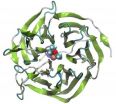(Press-News.org) Treating influenza relies on drugs such as Amantadine that are becoming less and less effective due to viral evolution. But University of Chicago scientists have published computational results that may give drug designers the insight they need to develop the next generation of effective influenza treatment.
"It's very hard to design a drug if you don't understand how the disease functions," said Gregory Voth, the Haig P. Papazian Distinguished Service Professor in Chemistry. Voth and three co-authors offer new insights into the disease's functioning in the Proceedings of the National Academy of Sciences Online Early Edition for the week of June 16-20, 2014.
Amantadine is a bulky organic compound originally designed to treat influenza A by blocking proton flow through the M2 channel, one of the few proteins that are targets for antiviral therapies. "The proton flow is essential for influenza viral replication," said Voth, who also is director of the Center for Multiscale Theory and Simulation. Unfortunately, subsequent mutations in different forms of the flu have changed the ability of Amantadine to bind to the M2 protein. "There's a big, worldwide push to find new drugs that will block this or other influenza proteins," Voth said.
Route to new, better drugs
"Dr. Voth and his colleagues have simulated the process of proton transfer through the M2 channel and the effects of mutations that cause resistance to drugs that block this channel at a level of detail not previously possible," said Dr. Peter Preusch of the National Institutes of Health's National Institute of General Medical Sciences, which funded the research. "This work helps expand the methods for molecular simulation available to researchers and may eventually lead to new and better drugs to treat influenza infections."
The UChicago team conducted extensive multiscale simulations of proton permeation, a critical step in viral replication, through the M2 channel from influenza A. The simulations enabled them to visualize this process at three interconnected scales, from the electronic (the smallest), to the molecular (intermediate) to the mesoscopic (the largest). The capability of the technique was demonstrated by last year's Nobel Prize in Chemistry, which was awarded to three scientists "for the development of multiscale models for complex chemical systems."
"Computer simulation, when done very well, with all the right physics, reveals a huge amount of information that you can't get otherwise," Voth said. "In principle you could do these calculations with potential drug targets and see how they bind and if they are in fact effective."
The flow of protons through the watery M2 channel is a complex process, one involving many phenomena, including the making and breaking of chemical bonds. Scientists have attempted to simulate this process computationally for more than 20 years to understand how it works, but only now has the feat been achieved. No other experimental or simulation technique is capable of examining the proton flow process in such detail.
Scientists have, however, succeeded in experimentally producing mutations of different parts of the M2 protein. The UChicago team's simulations of the protein's dynamics not only agree with those experimental data, which validates the results, but also explains the effects of these mutations, one of which is a dominant cause of drug resistance.
Yearlong high-performance operation
To reach such significant conclusions, the UChicago team tapped the power of four high-performance computer clusters. Principal among these was the Midway high performance computing cluster at the University's Research Computing Center. The Midway cluster worked various aspects of the problem continually for an entire year under the watchful guidance of Ruibin Liang, a graduate student in chemistry and the study's lead author.
But the team also needed clusters at the Texas Advanced Computing Center at the University of Texas at Austin, the San Diego Supercomputer Center at the University of San Diego, and the Department of Defense High Performance Computing Center in Vicksburg, Miss.
"This was a huge amount of work, so I used every resource available. Professor Voth devoted a lot of machine time to this project," Liang said.
More work lies ahead for Voth and his team, including trying to make the simulation process run more quickly, explaining the effects of drug resistant mutations, and targeting other forms of influenza. According the Liang, the stage has been set and the work is underway to reveal the proton permeation mechanism in influenza B, another form of the flu that has a different M2 channel and is entirely resistant to drugs like Amantidine.
INFORMATION:
Citation: "Multiscale Simulation Reveals a Multifacted Mechanism of Proton Permeation through the Influenza A M2 Proton Channel," by Ruibin Liang, Hui Li, Jessica M. J. Swanson, and Gregory A. Voth, Proceedings of the National Academy of Sciences Online Early Edition for the week of June 16-20, 2014, DOI 10.1073/pnas.1401997111.
Funding: National Institutes of Health grant R01-GM053148.
Computation leads to better understanding of influenza virus replication
2014-06-16
ELSE PRESS RELEASES FROM THIS DATE:
Chemical strategy hints at better drugs for osteoporosis, diabetes
2014-06-16
MADISON, Wis. — By swapping replacement parts into the backbone of a synthetic hormone, UW–Madison graduate student Ross Cheloha and his mentor, Sam Gellman, along with collaborators at Harvard Medical School, have built a version of a parathyroid hormone that resists degradation in laboratory mice. As a result, the altered hormone can stay around longer — and at much higher concentration, says Gellman, professor of chemistry at the UW.
Hormones are signaling molecules that are distributed throughout the body, usually in the blood. Hormones elicit responses from only ...
No correlation between baby formulas and development of diabetes-associated autoantibodies
2014-06-16
ATLANTA—There is no correlation between the consumption of a cow's milk-based formula or hydrolyzed protein formula and the development of diabetes-associated autoantibodies in children younger than seven, according to a worldwide research study published in the Journal of the American Medical Association (JAMA).
The Trial to Reduce Insulin Dependent Diabetes Mellitus in the Genetically at Risk (TRIGR) study, which examines possible reduction in autoantibodies associated with type 1 diabetes, tracked children genetically predisposed to type 1 diabetes for seven years.
It ...
Controlling ragweed pollen in Detroit: A no-mow solution for Motown?
2014-06-16
ANN ARBOR—When it comes to controlling hay fever-triggering ragweed plants on Detroit vacant lots, occasional mowing is worse than no mowing at all, and promoting reforestation might be the best solution.
Those are the findings of a new University of Michigan study that surveyed vacant lots in several Detroit neighborhoods for ragweed, counting the number of ragweed plants and estimating how often each lot was mowed.
The researchers found that ragweed was significantly more likely to be present in vacant lots mowed once a year or once every two years—a common practice ...
In managing boundaries between work and home, technology can be both 'friend' and 'foe'
2014-06-16
When it comes to managing boundaries between work responsibilities and home life, technology is our "frenemy."
Technology, specifically mobile technology, can be alternately used to maintain, erase or manage home and work boundaries along a spectrum.
That's according to ongoing research by the University of Cincinnati to be presented June 17 at the Work and Family Researchers Network Conference in New York City by Stacie Furst-Holloway, UC associate professor of psychology. Co-authors with Furst-Holloway on the research are Elaine Hollensbee, associate professor of ...
University of Tennessee discoveries could help neutralize chemical weapons
2014-06-16
KNOXVILLE—Researchers at the University of Tennessee, Knoxville, are a step closer to creating a prophylactic drug that would neutralize the deadly effects of the chemical weapons used in Syria and elsewhere.
Jeremy Smith, UT-ORNL Governor's Chair and an expert in computational biology, is part of the team that is trying to engineer enzymes—called bioscavengers—so they work more efficiently against chemical weapons. The work is a joint effort between scientists at UT, Oak Ridge National Laboratory and a French national laboratory in Grenoble. Their study was published ...
Migratory birds help spread plant species across hemispheres
2014-06-16
A new study out of the University of Connecticut demonstrates for the first time how some plants travel not just across the backyard, but as far as from Northern to Southern hemispheres on the wings of migratory birds.
The findings, published in the online journal PeerJ, offer critical insight into the ecology and evolution of plants that are represented across both continents of the Americas.
The study found 23 regenerative plant diaspores – plant seeds or spores – trapped in the feathers of migratory birds leaving the Arctic harbor for South America.
Although wind ...
Vitamin A derivative potentially treats type 2 diabetes and prevents its complications
2014-06-16
At a time when obesity, type 2 diabetes, and their complications are a veritable epidemic worldwide, researchers at the University of Montreal and CHUM Research Centre (CRCHUM) recently demonstrated the potential of retinoic acid (RA), a derivative of Vitamin A, in treating obesity and type 2 diabetes and preventing their cardiovascular complications. The findings were presented June 6, 2014 at the Annual Conference of the Canadian Nutrition Society in Saint John's, Newfoundland.
"In obese and insulin resistant mice, retinoic acid reduces the risk of cardiac apoptosis, ...
Researchers use virus to reveal nanopore physics
2014-06-16
PROVIDENCE, R.I. [Brown University] — Nanopores may one day lead a revolution in DNA sequencing. By sliding DNA molecules one at a time through tiny holes in a thin membrane, it may be possible to decode long stretches of DNA at lightning speeds. Scientists, however, haven't quite figured out the physics of how polymer strands like DNA interact with nanopores. Now, with the help of a particular type of virus, researchers from Brown University have shed new light on this nanoscale physics.
"What got us interested in this was that everybody in the field studied DNA and ...
Strokefinder quickly differentiates bleeding strokes from clot-induced strokes
2014-06-16
The results from the initial clinical studies involving the microwave helmet Strokefinder confirm the usefulness of microwaves for rapid and accurate diagnosis of stroke patients. This is shown in a scientific article being published on June 16. Strokefinder enables earlier diagnosis than current methods, which improves the possibility to counteract brain damage.
In the article, researchers from Chalmers University of Technology, Sahlgrenska Academy and Sahlgrenska University Hospital present results from the initial patient studies completed last year. The study included ...
E-cigarettes far less harmful than cigarettes, says researcher at INFORMS Conference
2014-06-16
A London School of Economics researcher examining the public and private dangers of drugs argues against demonizing e-cigarettes in a presentation being given at a conference of the Institute for Operations Research and the Management Sciences (INFORMS). He also calls on public officials to recognize that alcohol causes greater harm than other recreational drugs and more public attention should be paid to controlling its harmful effects.
Lawrence D. Phillips, an emeritus professor at the London School of Economics, will present his research group's findings about the relative ...




